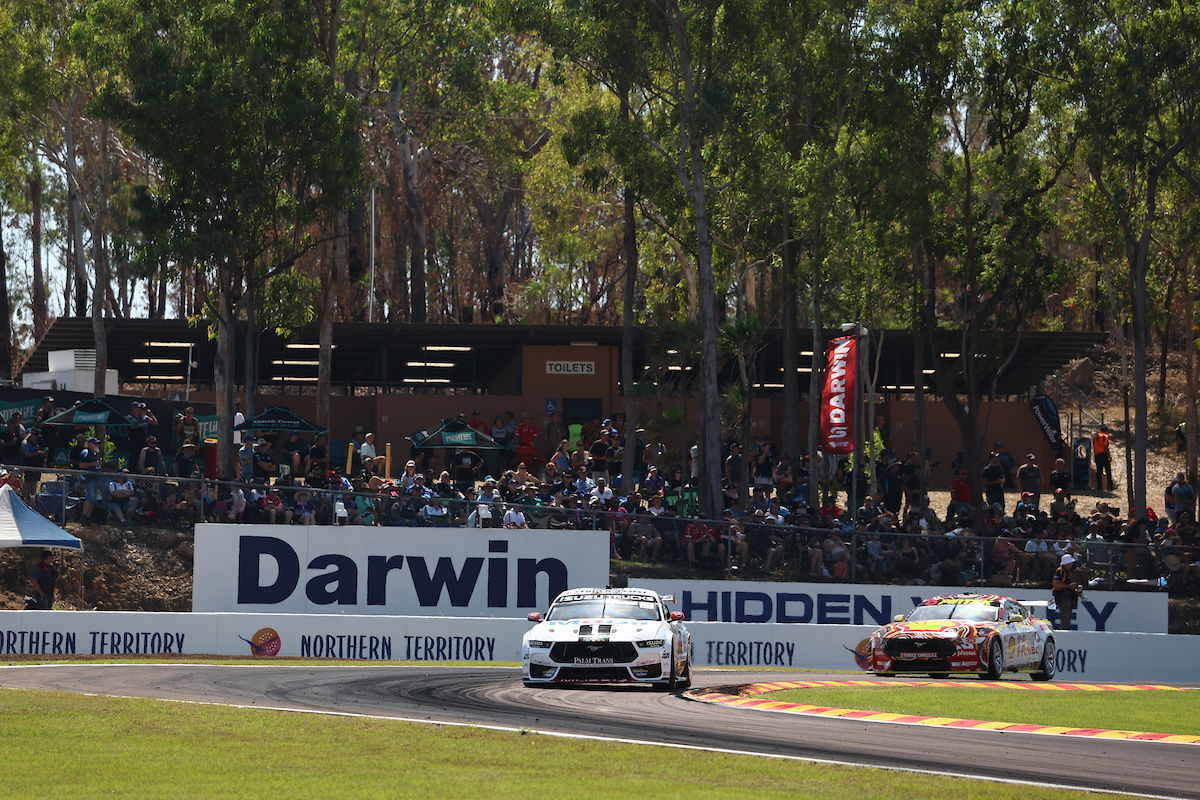

A new question has arisen in the parity furore which has erupted as a result of the Chevrolet Camaros’ dominance of the Darwin Supercars event.
The narrative from the Blue Oval brigade has now shifted to an emphasis on aerodynamics, with the question raised about yaw.
Camaros won all three races at Hidden Valley and scored eight of the nine podium finishes, the exception being a third place for Dick Johnson Racing’s Will Davison in Saturday’s Race 13 of the season.
It continued a trend in 2023, the first season of Gen3 Supercars, with Cameron Waters the sole Ford Mustang race winner for the year to date, and only because both Triple Eight Race Engineering entries were disqualified from Race 1 in Newcastle.
Waters was a pole-sitter at the Betr Darwin Triple Crown, having set the two fastest laps of the weekend in Qualifying for Race 13, and was the most likely victor until his Mustang caught fire while leading that afternoon’s 35-lapper.
Still, the thrashing which the Mustangs copped in Race 14 in particular, when Camaros locked out the top nine, was cause for serious concern among Ford teams.
Aerodynamics had been a point of contention in the latter months of calendar year 2022, and persisted as an issue until a ‘mini VCAT’ was held at Temora in late-February/early-March.
The ironic outcome was that the Camaro had around 5kg of downforce added to its front end, but it was thought then that the matter had been settled.
What was left open for changes was the Engine Specification Documents, with near-constant tinkering on the Ford calibration since the season began (and work also on the Chevrolet’s).
However, Grove Racing owner Stephen Grove declared via an incendiary Ford Performance press release that “There is a serious parity issue with the aero of the cars.”
The claim was that Ford drivers are suffering excessive rear tyre wear, a suggestion which arose multiple events ago in conjunction with a theory that poor throttle response/acceleration was inducing Mustang pilots into overdriving.
Now, Speedcafe understands the question of yaw is being raised among the Blue Oval contingent.
Yaw refers to how a vehicle rotates around its vertical axis and, in car racing terms, is looked at in terms of how the back end of the car moves to one side while cornering.
In short, a theory has now arisen that the Mustang is at a disadvantage compared to the Camaro in cornering.
If the Mustang does have inferior yaw properties, then it would be less planted in turns, hence the rear end of the car slides, and the rear tyres wear out more than they otherwise would.
Yaw is a known property within Supercars, and explains why the Gen2 Mustang sported gargantuan wing endplates, even after they were trimmed in early-2019.
The large endplates help capture the air which is flowing over the car’s ‘wind-licked surfaces’ and direct the airflow to the rear wing, promoting rear downforce and thus reducing yaw.
Significantly, while Supercars’ VCAT process captures aerodynamic properties when the car is travelling in a straight line, there is no yaw measurement.
However, the significance of yaw in a Supercars context is debated.
Firstly, a Gen3 Supercar has somewhere in the region of 150kg to 160kg of total downforce at 200km/h, based on the category’s claim that downforce was slashed by about 64 percent relative to Gen2.
While downforce is greater at the rear than the front, the rear downforce figure is relatively low by modern race car standards, and Supercars rarely corner so quickly anyway.
Furthermore, the wing plane is common from Camaro to Mustang and the endplates are similar, as are the mounting points, although the mounts are differently shaped and the Camaro’s have a gap in them whereas the Mustang’s do not.
A further theory which has emerged about tyre wear, although one on which there is less emphasis, relates to the shorter shift cut to which the Mustangs are running.
The Camaro’s was elongated to 105ms before the season started while the Mustang’s has run as short as 30ms, as opposed to the standard 50ms which would ordinarily apply to both vehicles.
One school of thought is that the 30ms cut, referred to at Symmons Plains by Tickford Racing’s Tim Edwards as a parity “band-aid” measure, may be causing rear tyres to spin on upshifts.
Whatever the concern(s) may be, there is little sympathy from their rivals, particularly considering Waters’ Saturday performance at Hidden Valley.
One Chevrolet figure told Speedcafe, “They’ve got one Mustang that’s capable of qualifying on pole that would have won the race.
“It begs the question why the others can’t do that.”
In the drivers’ championship, it is now an all-Chevrolet top four with Erebus Motorsport’s Brodie Kostecki leading team-mate Will Brown, from Triple Eight Race Engineering duo Broc Feeney and Shane van Gisbergen.
With calls for changes from Ford team bosses, a Supercars spokesperson told Speedcafe following the Darwin Triple Crown, “The Technical Working Group will continue to work closely with both homologation teams leading into the Townsville 500.”
The NTI Townsville 500 takes place on July 7-9.





















Discussion about this post